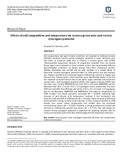Effects of soil composition and temperature on cassava green mite and variety cyanogens potential

View/
Date
2014-04Author
Mutisya, Daniel L
Gichangi, E M
Kariuki, CW
Miano, D
Language
enMetadata
Show full item recordAbstract
oil compositions and agro-climatic conditions are reported to influence cassava (Manihot esculenta Crantz) variety cyanogens potential. A major herbivore pest that leads to economic yield lose in cassava is cassava green mite (CGM), Mononychellus progresivus Doreste. M. progresivus collected from the coastal Kenya region was evaluated on three varieties at four sites representing different agro-ecological conditions in Kenya during 2011-2013 production periods. Another evaluation was carried out on nine varieties in a screen house to determine varietal cyanogens potential effect to CGM growth and leaf biomass loss. Highest cyanide levels attracted highest CGM density and led to highest leaf biomass loss. Cassava green mite’s densities were significantly higher in the dry low midlands of eastern Kenya than at the cooler upper midlands and humid low coastal lands. Leaf cyanogens potential (HCN) were highest at Embu (UM3) than the other sites. Variety MM990183 led with 32.5 ± 4.8 while MM99005 and Ex-Mariakani had 20.6 ± 1.8 and 20.2 ± 2.3 cyanogens levels, respectively. The least HCN was recorded from Mtwapa site (CL3), of 6.5 ± 4.5, 16.3 and 11.4 mg/kg per leaf, for Ex-Mariakani, MM99005 and MM990183. The effect of temperature on CGM numbers was found positively correlated (R2 = 0.6024) indicating high increase of pest density with temperature increase. A low correlation was observed with leaf HCN to CGM density (R2 = 0.1686), where increase of HCN level demonstrated a strong increase of pest density. A clear strong correlation to CGM density was scored where temperature and rainfall were the combined environmental factors (R2 = 0.7656). Similarly, a strong correlation of rainfall and pH level to CGM density growth was shown (R2 = 0.7722). The information on cassava variety cyanogens potential is important for breeding varieties safe for human consumption and which bear little damage from M. progresivus mite pest.
URI
https://www.academiapublishing.org/journals/ajar/abstract/2014/Apr/Mutisya%20et%20al.htmhttp://hdl.handle.net/11295/91641
Citation
Mutisya, D. L., Gichangi, E. M., Kariuki, C. W., & Miano, D. (2014). Effects of soil composition and temperature on cassava green mite and variety cyanogens potential. Academia Journal of Agricultural Research, 2(4), 114-121.Publisher
University of Nairobi
